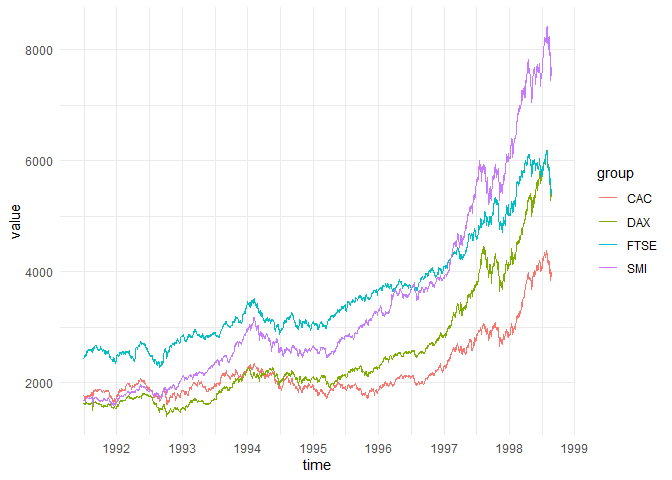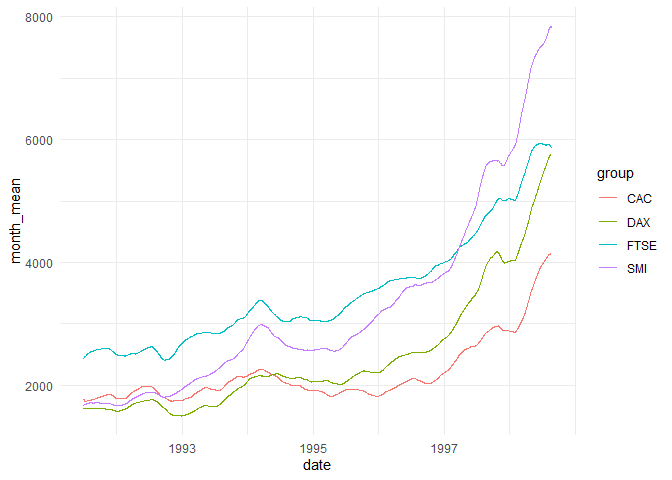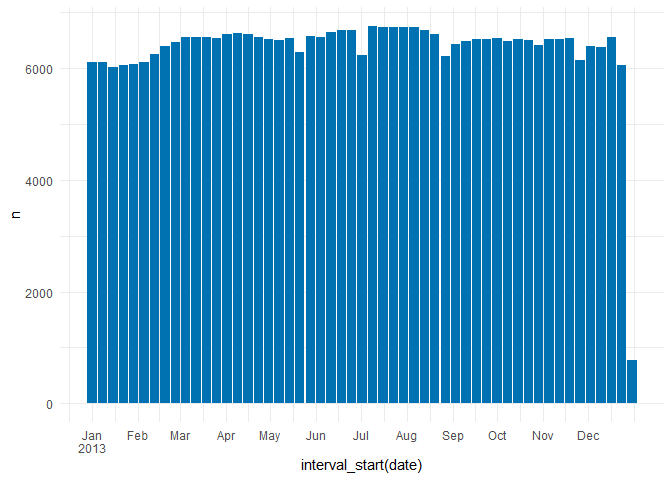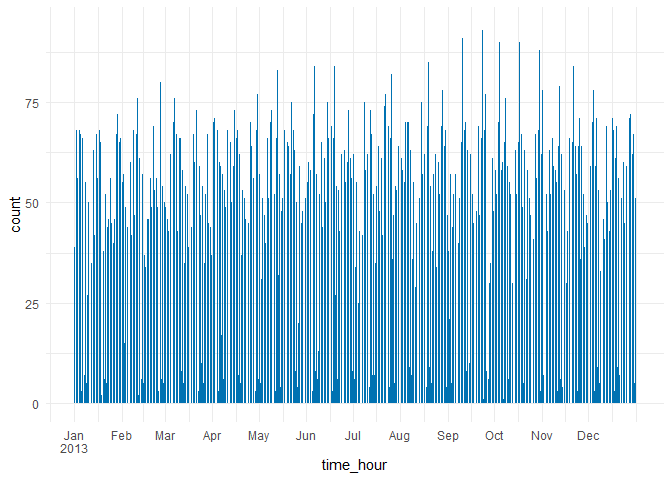This package provides a set of functions to make working with date and datetime data much easier!
While most time-based packages are designed to work with clean and pre-aggregate data, timeplyr contains a set of tidy tools to complete, expand and summarise both raw and aggregate date/datetime data.
Significant efforts have been made to ensure that grouped calculations are fast and efficient thanks to the excellent functionality within the collapse package.
You can install and load timeplyr using the below
code.
# CRAN version
install.packages("timeplyr")
# Development version
remotes::install_github("NicChr/timeplyr")library(timeplyr)
library(tidyverse)
#> ── Attaching core tidyverse packages ──────────────────────── tidyverse 2.0.0 ──
#> ✔ dplyr 1.1.4 ✔ readr 2.1.5
#> ✔ forcats 1.0.0 ✔ stringr 1.5.1
#> ✔ ggplot2 3.5.1 ✔ tibble 3.2.1
#> ✔ lubridate 1.9.4 ✔ tidyr 1.3.1
#> ✔ purrr 1.0.4
#> ── Conflicts ────────────────────────────────────────── tidyverse_conflicts() ──
#> ✖ dplyr::filter() masks stats::filter()
#> ✖ dplyr::lag() masks stats::lag()
#> ✖ ggplot2::resolution() masks timeplyr::resolution()
#> ℹ Use the conflicted package (<http://conflicted.r-lib.org/>) to force all conflicts to become errors
library(fastplyr)
#>
#> Attaching package: 'fastplyr'
#>
#> The following object is masked from 'package:dplyr':
#>
#> desc
#>
#> The following objects are masked from 'package:tidyr':
#>
#> crossing, nesting
library(nycflights13)
library(lubridate)start <- dmy("01-01-2000")
start |>
time_add("year")
#> [1] "2001-01-01"Internally timeplyr makes use of custom timespan objects
for various time manipulations.
timespan("months"); timespan("1 month"); timespan(months(1))
#> <Timespan:months>
#> [1] 1
#> <Timespan:months>
#> [1] 1
#> <Timespan:months>
#> [1] 1
timespan("weeks", 1:10)
#> <Timespan:weeks>
#> [1] 1 2 3 4 5 6 7 8 9 10
# Parsing
start |> time_add("10 years"); start |> time_add("decade")
#> [1] "2010-01-01"
#> [1] "2010-01-01"
# Lubridate style timespans
start |>
time_add(years(1))
#> [1] "2001-01-01"
start |> time_add(dyears(1)); start |> time_add("31557600 seconds")
#> [1] "2000-12-31 06:00:00 UTC"
#> [1] "2000-12-31 06:00:00 UTC"
# timeplyr timespans
start |>
time_add(timespan("years", 1))
#> [1] "2001-01-01"
start |>
time_add(timespan("years", 0:10))
#> [1] "2000-01-01" "2001-01-01" "2002-01-01" "2003-01-01" "2004-01-01"
#> [6] "2005-01-01" "2006-01-01" "2007-01-01" "2008-01-01" "2009-01-01"
#> [11] "2010-01-01"Time arithmetic involving days, weeks, months and years is equivalent to using lubridate periods.
Any arithmetic involving units less than days, e.g. hours, minutes and seconds, uses normal duration arithmetic in terms of how many seconds have passed. This is equivalent to using lubridate durations.
# Clocks go back 1 hour at exactly 2 am
dst <- dmy_hms("26-10-2025 00:00:00", tz = "GB") |> time_add("hour")
# Below 2 are equivalent
dst |>
time_add(timespan("hours", 0:2))
#> [1] "2025-10-26 01:00:00 BST" "2025-10-26 01:00:00 GMT"
#> [3] "2025-10-26 02:00:00 GMT"
dst + dhours(0:2)
#> [1] "2025-10-26 01:00:00 BST" "2025-10-26 01:00:00 GMT"
#> [3] "2025-10-26 02:00:00 GMT"
# There is currently no timeplyr way to achieve the below result
# 1 hour forward in clock time is actually 2 literal hours forward
dst + hours(0:2)
#> [1] "2025-10-26 01:00:00 BST" "2025-10-26 02:00:00 GMT"
#> [3] "2025-10-26 03:00:00 GMT"Period-based hours, minutes and seconds are not as commonly used as literal duration-based hours, minutes and seconds. Therefore timeplyr tries to simplify things by removing the distinction and automatically choosing periods for units larger than an hour and durations for units smaller than a day without the user having to contemplate which to use.
# The lubridate and timeplyr equivalents
time_add(dst, "second"); dst + dseconds(1)
#> [1] "2025-10-26 01:00:01 BST"
#> [1] "2025-10-26 01:00:01 BST"
time_add(dst, "minute"); dst + dminutes(1)
#> [1] "2025-10-26 01:01:00 BST"
#> [1] "2025-10-26 01:01:00 BST"
time_add(dst, "hour"); dst + dhours(1)
#> [1] "2025-10-26 01:00:00 GMT"
#> [1] "2025-10-26 01:00:00 GMT"
time_add(dst, "day"); dst + days(1)
#> [1] "2025-10-27 01:00:00 GMT"
#> [1] "2025-10-27 01:00:00 GMT"
time_add(dst, "week"); dst + weeks(1)
#> [1] "2025-11-02 01:00:00 GMT"
#> [1] "2025-11-02 01:00:00 GMT"
time_add(dst, "month"); dst + months(1)
#> [1] "2025-11-26 01:00:00 GMT"
#> [1] "2025-11-26 01:00:00 GMT"
time_add(dst, "year"); dst + years(1)
#> [1] "2026-10-26 01:00:00 GMT"
#> [1] "2026-10-26 01:00:00 GMT"Time differences are accurate and simple
start <- today()
end <- today() |> time_add("decade")
time_diff(start, end, "years")
#> [1] 10
for (unit in .period_units){
cat(unit, ":", time_diff(start, end, unit), "\n")
}
#> seconds : 315532800
#> minutes : 5258880
#> hours : 87648
#> days : 3652
#> weeks : 521.7143
#> months : 120
#> years : 10When months and years are involved, timeplyr rolls impossible dates forward by default which is different to lubridate which rolls backwards by default
leap <- dmy("29-02-2020")
leap |> time_add("year"); leap |> add_with_rollback(years(1))
#> [1] "2021-03-01"
#> [1] "2021-02-28"timeplyr handles month addition symmetrically by rolling backwards when adding negative months
leap |> time_subtract("year")
#> [1] "2019-02-28"This can all be controlled through the roll_month
argument which has options ‘xfirst’, ‘xlast’, ‘preday’, ‘postday’,
‘boundary’, ‘full’ and ‘NA’. The ‘xfirst’ and ‘xlast’ options are
timeplyr specific and signify crossed-first and crossed-last dates
respectively. ‘xlast’ is set by default package-wide.
The choice of rolling impossible dates can affect time difference calculations.
# timeplyr
leap_almost_one_year_old <- dmy("28-02-2021")
cat("timeplyr: ", time_diff(leap, leap_almost_one_year_old, "years"), "\n",
"lubridate: ", interval(leap, leap_almost_one_year_old) / years(1),
sep = "")
#> timeplyr: 0.9972678
#> lubridate: 1In the above example timeplyr lets leaplings be younger for an extra day!
Monthly time differences in timeplyr are symmetric, regardless if
x > y or x < y
time_diff(leap, dmy("28-02-2021") + days(0:1), "years")
#> [1] 0.9972678 1.0000000
time_diff(leap, dmy("01-03-2019") - days(0:1), "years")
#> [1] -0.9972678 -1.0000000
# Not symmetric
interval(leap, dmy("28-02-2021") + days(0:1)) / years(1)
#> [1] 1.00000 1.00274
interval(leap, dmy("01-03-2019") - days(0:1)) / years(1)
#> [1] -0.9972678 -1.0000000timeplyr makes use of its own custom time intervals. These are
intervals of a fixed width. For example, R Dates can be thought of as
fixed intervals of exactly 1 day width. In fact if you call
time_interval() on a Date vector this is exactly what you
get.
time_interval(today())
#> <time_interval> [width:1D]
#> [1] [2025-02-28, +1D)Going into more detail, timeplyr uses the ‘resolution’ of the object to calculate the default width. Here, ‘resolution’ is defined as the ‘smallest timespan that differentiates two non-fractional instances in time’.
For dates this is one day
resolution(today())
#> [1] 1For date-times this is one second
resolution(now())
#> [1] 1Another concept timeplyr introduces is ‘granularity’. This is defined as ‘the smallest common time difference’ which is a metric designed to estimate the level of detail or frequency in which the dates are recorded.
In the flights dataset, flight information is recorded
every hour, or within hourly intervals, meaning that the level of detail
(or granularity) within this dataset is hourly.
granularity(flights$time_hour)
#> <Timespan:hours>
#> [1] 1To convert these implicit intervals into explicit intervals we can
use time_cut_width which places these hours into hourly
intervals. It places them by default into hourly intervals because it
calls granularity() by default.
time_cut_width(flights$time_hour) |> head()
#> <time_interval> [width:1h]
#> [1] [2013-01-01 05:00:00, +1h) [2013-01-01 05:00:00, +1h)
#> [3] [2013-01-01 05:00:00, +1h) [2013-01-01 05:00:00, +1h)
#> [5] [2013-01-01 06:00:00, +1h) [2013-01-01 05:00:00, +1h)
# Identically
time_cut_width(flights$time_hour, "1 hour") |> head()
#> <time_interval> [width:1h]
#> [1] [2013-01-01 05:00:00, +1h) [2013-01-01 05:00:00, +1h)
#> [3] [2013-01-01 05:00:00, +1h) [2013-01-01 05:00:00, +1h)
#> [5] [2013-01-01 06:00:00, +1h) [2013-01-01 05:00:00, +1h)A common task is to places dates into larger time intervals, e.g. converting hourly data into weekly data.
time_cut_width(flights$time_hour, "week") |>
as_tbl() |>
count(value)
#> # A tibble: 53 × 2
#> value n
#> <tm_ntrvl> <int>
#> 1 [2013-01-01 05:00:00, +1W) 6099
#> 2 [2013-01-08 05:00:00, +1W) 6109
#> 3 [2013-01-15 05:00:00, +1W) 6018
#> 4 [2013-01-22 05:00:00, +1W) 6060
#> 5 [2013-01-29 05:00:00, +1W) 6072
#> 6 [2013-02-05 05:00:00, +1W) 6101
#> 7 [2013-02-12 05:00:00, +1W) 6255
#> 8 [2013-02-19 05:00:00, +1W) 6394
#> 9 [2013-02-26 05:00:00, +1W) 6460
#> 10 [2013-03-05 05:00:00, +1W) 6549
#> # ℹ 43 more rowsTo get full weeks, simply utilise the from arg with
floor_date()
time_cut_width(
flights$time_hour, "week" , from = min(floor_date(flights$time_hour, "week"))
) |>
as_tbl() |>
count(value)
#> # A tibble: 53 × 2
#> value n
#> <tm_ntrvl> <int>
#> 1 [2012-12-30, +1W) 4334
#> 2 [2013-01-06, +1W) 6118
#> 3 [2013-01-13, +1W) 6076
#> 4 [2013-01-20, +1W) 6012
#> 5 [2013-01-27, +1W) 6072
#> 6 [2013-02-03, +1W) 6089
#> 7 [2013-02-10, +1W) 6217
#> 8 [2013-02-17, +1W) 6349
#> 9 [2013-02-24, +1W) 6411
#> 10 [2013-03-03, +1W) 6551
#> # ℹ 43 more rowsSome common metadata functions
int <- time_cut_width(today() + days(0:13), timespan("weeks"))
interval_width(int)
#> <Timespan:weeks>
#> [1] 1
interval_range(int)
#> [1] "2025-02-28" "2025-03-14"
interval_start(int)
#> [1] "2025-02-28" "2025-02-28" "2025-02-28" "2025-02-28" "2025-02-28"
#> [6] "2025-02-28" "2025-02-28" "2025-03-07" "2025-03-07" "2025-03-07"
#> [11] "2025-03-07" "2025-03-07" "2025-03-07" "2025-03-07"
interval_end(int)
#> [1] "2025-03-07" "2025-03-07" "2025-03-07" "2025-03-07" "2025-03-07"
#> [6] "2025-03-07" "2025-03-07" "2025-03-14" "2025-03-14" "2025-03-14"
#> [11] "2025-03-14" "2025-03-14" "2025-03-14" "2025-03-14"
interval_count(int)
#> # A tibble: 2 × 2
#> interval n
#> <tm_ntrvl> <int>
#> 1 [2025-02-28, +1W) 7
#> 2 [2025-03-07, +1W) 7For the R veterans among you who would like more detail,
timespans and time_intervals are both
lightweight S3 objects with some very basic attributes, making them work
quite fast in R.
timespans are simply numeric vectors with a time unit
attribute.
time_intervals are the unclassed version of the time
object they are representing, along with a timespan
attribute to record the interval width, as well as an attribute to
record the original class.
There are many methods written for both objects to ensure they work seamlessly with most R functions.
timespan("days", 1:3) |> unclass()
#> [1] 1 2 3
#> attr(,"unit")
#> [1] "days"
time_interval(today()) |> unclass()
#> [1] 20147
#> attr(,"timespan")
#> <Timespan:days>
#> [1] 1
#> attr(,"old_class")
#> [1] "Date"ts, mts, xts, zooand
timeSeries objects using ts_as_tbleu_stock <- EuStockMarkets |>
ts_as_tbl()
eu_stock
#> # A tibble: 7,440 × 3
#> group time value
#> <chr> <dbl> <dbl>
#> 1 DAX 1991. 1629.
#> 2 DAX 1992. 1614.
#> 3 DAX 1992. 1607.
#> 4 DAX 1992. 1621.
#> 5 DAX 1992. 1618.
#> 6 DAX 1992. 1611.
#> 7 DAX 1992. 1631.
#> 8 DAX 1992. 1640.
#> 9 DAX 1992. 1635.
#> 10 DAX 1992. 1646.
#> # ℹ 7,430 more rowstime_ggploteu_stock |>
time_ggplot(time, value, group)
For the next examples we use flights departing from New York City in 2013.
library(nycflights13)
library(lubridate)
flights <- flights |>
mutate(date = as_date(time_hour))time_byflights_monthly <- flights |>
select(date, arr_delay) |>
time_by(date, "month")
flights_monthly
#> # A tibble: 336,776 x 2
#> # Time: date [12]
#> # Width: month
#> # Range: 2013-01-01 -- 2014-01-01
#> date arr_delay
#> <tm_ntrvl> <dbl>
#> 1 [2013-01-01, +1M) 11
#> 2 [2013-01-01, +1M) 20
#> 3 [2013-01-01, +1M) 33
#> 4 [2013-01-01, +1M) -18
#> 5 [2013-01-01, +1M) -25
#> 6 [2013-01-01, +1M) 12
#> 7 [2013-01-01, +1M) 19
#> 8 [2013-01-01, +1M) -14
#> 9 [2013-01-01, +1M) -8
#> 10 [2013-01-01, +1M) 8
#> # ℹ 336,766 more rowsWe can then use this to create a monthly summary of the number of flights and average arrival delay
flights_monthly |>
f_summarise(n = n(),
mean_arr_delay = mean(arr_delay, na.rm = TRUE))
#> # A tibble: 12 × 3
#> date n mean_arr_delay
#> <tm_ntrvl> <int> <dbl>
#> 1 [2013-01-01, +1M) 27004 6.13
#> 2 [2013-02-01, +1M) 24951 5.61
#> 3 [2013-03-01, +1M) 28834 5.81
#> 4 [2013-04-01, +1M) 28330 11.2
#> 5 [2013-05-01, +1M) 28796 3.52
#> 6 [2013-06-01, +1M) 28243 16.5
#> 7 [2013-07-01, +1M) 29425 16.7
#> 8 [2013-08-01, +1M) 29327 6.04
#> 9 [2013-09-01, +1M) 27574 -4.02
#> 10 [2013-10-01, +1M) 28889 -0.167
#> 11 [2013-11-01, +1M) 27268 0.461
#> 12 [2013-12-01, +1M) 28135 14.9If the time unit is left unspecified, the time functions
try to find the highest time unit possible.
flights |>
time_by(time_hour)
#> # A tibble: 336,776 x 20
#> # Time: time_hour [6,936]
#> # Width: hour
#> # Range: 2013-01-01 05:00:00 -- 2014-01-01
#> year month day dep_time sched_dep_time dep_delay arr_time sched_arr_time
#> <int> <int> <int> <int> <int> <dbl> <int> <int>
#> 1 2013 1 1 517 515 2 830 819
#> 2 2013 1 1 533 529 4 850 830
#> 3 2013 1 1 542 540 2 923 850
#> 4 2013 1 1 544 545 -1 1004 1022
#> 5 2013 1 1 554 600 -6 812 837
#> 6 2013 1 1 554 558 -4 740 728
#> 7 2013 1 1 555 600 -5 913 854
#> 8 2013 1 1 557 600 -3 709 723
#> 9 2013 1 1 557 600 -3 838 846
#> 10 2013 1 1 558 600 -2 753 745
#> # ℹ 336,766 more rows
#> # ℹ 12 more variables: arr_delay <dbl>, carrier <chr>, flight <int>,
#> # tailnum <chr>, origin <chr>, dest <chr>, air_time <dbl>, distance <dbl>,
#> # hour <dbl>, minute <dbl>, time_hour <tm_ntrvl>, date <date>missing_dates(flights$date) # No missing dates
#> Date of length 0time_num_gaps(flights$time_hour) # Missing hours
#> [1] 1819To check for regularity use time_is_regular
hours <- sort(flights$time_hour)
time_is_regular(hours, "hours")
#> [1] FALSE
time_is_regular(hours, "hours", allow_gaps = TRUE, allow_dups = TRUE)
#> [1] TRUE
# By-group
time_num_gaps(flights$time_hour, g = flights$origin)
#> EWR JFK LGA
#> 2489 1820 2468
time_is_regular(flights$time_hour, g = flights$origin)
#> EWR JFK LGA
#> FALSE FALSE FALSEeu_stock <- eu_stock |>
mutate(date = date_decimal(time))
eu_stock |>
mutate(month_mean = time_roll_mean(value, window = months(3),
time = date,
g = group)) |>
time_ggplot(date, month_mean, group)
# Prerequisite: Create Time series with missing values
x <- ts(c(NA, 3, 4, NA, 6, NA, NA, 8))
g <- cheapr::seq_id(c(3, 5)) # Two groups of size 3 + 5
roll_na_fill(x) # Simple locf fill
#> Time Series:
#> Start = 1
#> End = 8
#> Frequency = 1
#> [1] NA 3 4 4 6 6 6 8
roll_na_fill(x, fill_limit = 1) # Fill up to 1 NA
#> Time Series:
#> Start = 1
#> End = 8
#> Frequency = 1
#> [1] NA 3 4 4 6 6 NA 8
roll_na_fill(x, g = g) # Very efficient on large data too
#> Time Series:
#> Start = 1
#> End = 8
#> Frequency = 1
#> [1] NA 3 4 NA 6 6 6 8year_month and
year_quartertimeplyr has its own lightweight ‘yearmonth’ and `yearquarter’ classes inspired by the excellent ‘zoo’ and ‘tsibble’ packages.
today <- today()
year_month(today)
#> [1] "2025 Feb"The underlying data for a year_month is the number of
months since 1 January 1970 (epoch).
unclass(year_month("1970-01-01"))
#> [1] 0
unclass(year_month("1971-01-01"))
#> [1] 12To create a sequence of ‘year_months’, one can use base arithmetic
year_month(today) + 0:12
#> [1] "2025 Feb" "2025 Mar" "2025 Apr" "2025 May" "2025 Jun" "2025 Jul"
#> [7] "2025 Aug" "2025 Sep" "2025 Oct" "2025 Nov" "2025 Dec" "2026 Jan"
#> [13] "2026 Feb"
year_quarter(today) + 0:4
#> [1] "2025 Q1" "2025 Q2" "2025 Q3" "2025 Q4" "2026 Q1"time_elapsed()Let’s look at the time between consecutive flights for a specific flight number
set.seed(42)
flight_201 <- flights |>
f_distinct(time_hour, flight) |>
f_filter(flight %in% sample(flight, size = 1)) |>
f_arrange(time_hour)
tail(sort(table(time_elapsed(flight_201$time_hour, "hours"))))
#>
#> 23 25 48 6 18 24
#> 2 3 4 33 34 218Flight 201 seems to depart mostly consistently every 24 hours
We can efficiently do the same for all flight numbers
# We use fdistinct with sort as it's much faster and simpler to write
all_flights <- flights |>
f_distinct(flight, time_hour, .sort = TRUE)
all_flights <- all_flights |>
mutate(elapsed = time_elapsed(time_hour, g = flight, fill = 0))
# Flight numbers with largest relative deviation in time between flights
all_flights |>
tidy_quantiles(elapsed, .by = flight, pivot = "wide") |>
mutate(relative_iqr = p75 / p25) |>
f_arrange(desc(relative_iqr))
#> # A tibble: 3,844 × 7
#> flight p0 p25 p50 p75 p100 relative_iqr
#> <int> <dbl> <dbl> <dbl> <dbl> <dbl> <dbl>
#> 1 3664 0 12 24 3252 6480 271
#> 2 5709 0 12 24 3080. 6137 257.
#> 3 513 0 12 24 2250. 4477 188.
#> 4 3364 0 12 24 2204. 4385 184.
#> 5 1578 0 24 48 4182. 8317 174.
#> 6 1830 0 1 167 168 168 168
#> 7 1569 0 18 105 2705 2787 150.
#> 8 1997 0 18 96 2158 8128 120.
#> 9 663 0 24 119 2604 3433 108.
#> 10 233 0 7 14 718 1422 103.
#> # ℹ 3,834 more rowstime_seq_id() allows us to create unique IDs for regular
sequences A new ID is created every time there is a gap in the
sequence
flights |>
f_select(time_hour) |>
f_arrange(time_hour) |>
mutate(time_id = time_seq_id(time_hour)) |>
f_filter(time_id != lag(time_id)) |>
f_count(hour(time_hour))
#> # A tibble: 2 × 2
#> `hour(time_hour)` n
#> <int> <int>
#> 1 1 1
#> 2 5 364We can see that the gaps typically occur at 11pm and the sequence resumes at 5am.
calendar()flights_calendar <- flights |>
f_select(time_hour) |>
reframe(calendar(time_hour))Now that gaps in time have been filled and we have joined our date table, it is easy to count by any time dimension we like
flights_calendar |>
f_count(isoyear, isoweek)
#> # A tibble: 53 × 3
#> isoyear isoweek n
#> <int> <int> <int>
#> 1 2013 1 5166
#> 2 2013 2 6114
#> 3 2013 3 6034
#> 4 2013 4 6049
#> 5 2013 5 6063
#> 6 2013 6 6104
#> 7 2013 7 6236
#> 8 2013 8 6381
#> 9 2013 9 6444
#> 10 2013 10 6546
#> # ℹ 43 more rows
flights_calendar |>
f_count(isoweek = iso_week(time))
#> # A tibble: 53 × 2
#> isoweek n
#> <chr> <int>
#> 1 2013-W01 5166
#> 2 2013-W02 6114
#> 3 2013-W03 6034
#> 4 2013-W04 6049
#> 5 2013-W05 6063
#> 6 2013-W06 6104
#> 7 2013-W07 6236
#> 8 2013-W08 6381
#> 9 2013-W09 6444
#> 10 2013-W10 6546
#> # ℹ 43 more rows
flights_calendar |>
f_count(month_l)
#> # A tibble: 12 × 2
#> month_l n
#> <ord> <int>
#> 1 Jan 27004
#> 2 Feb 24951
#> 3 Mar 28834
#> 4 Apr 28330
#> 5 May 28796
#> 6 Jun 28243
#> 7 Jul 29425
#> 8 Aug 29327
#> 9 Sep 27574
#> 10 Oct 28889
#> 11 Nov 27268
#> 12 Dec 28135time_seq()A lubridate version of seq() for dates and datetimes
start <- dmy(31012020)
end <- start + years(1)
seq(start, end, by = "month") # Base R version
#> [1] "2020-01-31" "2020-03-02" "2020-03-31" "2020-05-01" "2020-05-31"
#> [6] "2020-07-01" "2020-07-31" "2020-08-31" "2020-10-01" "2020-10-31"
#> [11] "2020-12-01" "2020-12-31" "2021-01-31"
time_seq(start, end, "month") # lubridate version
#> [1] "2020-01-31" "2020-03-01" "2020-03-31" "2020-05-01" "2020-05-31"
#> [6] "2020-07-01" "2020-07-31" "2020-08-31" "2020-10-01" "2020-10-31"
#> [11] "2020-12-01" "2020-12-31" "2021-01-31"time_seq() doesn’t mind mixing dates and datetimes
time_seq(start, as_datetime(end), "2 weeks")
#> [1] "2020-01-31 UTC" "2020-02-14 UTC" "2020-02-28 UTC" "2020-03-13 UTC"
#> [5] "2020-03-27 UTC" "2020-04-10 UTC" "2020-04-24 UTC" "2020-05-08 UTC"
#> [9] "2020-05-22 UTC" "2020-06-05 UTC" "2020-06-19 UTC" "2020-07-03 UTC"
#> [13] "2020-07-17 UTC" "2020-07-31 UTC" "2020-08-14 UTC" "2020-08-28 UTC"
#> [17] "2020-09-11 UTC" "2020-09-25 UTC" "2020-10-09 UTC" "2020-10-23 UTC"
#> [21] "2020-11-06 UTC" "2020-11-20 UTC" "2020-12-04 UTC" "2020-12-18 UTC"
#> [25] "2021-01-01 UTC" "2021-01-15 UTC" "2021-01-29 UTC"It is also vectorised
# 3 sequences
time_seq(from = start,
to = end,
timespan("months", 1:3))
#> [1] "2020-01-31" "2020-03-01" "2020-03-31" "2020-05-01" "2020-05-31"
#> [6] "2020-07-01" "2020-07-31" "2020-08-31" "2020-10-01" "2020-10-31"
#> [11] "2020-12-01" "2020-12-31" "2021-01-31" "2020-01-31" "2020-03-31"
#> [16] "2020-05-31" "2020-07-31" "2020-10-01" "2020-12-01" "2021-01-31"
#> [21] "2020-01-31" "2020-05-01" "2020-07-31" "2020-10-31" "2021-01-31"
# Equivalent to
c(time_seq(start, end, "month"),
time_seq(start, end, "2 months"),
time_seq(start, end, "3 months"))
#> [1] "2020-01-31" "2020-03-01" "2020-03-31" "2020-05-01" "2020-05-31"
#> [6] "2020-07-01" "2020-07-31" "2020-08-31" "2020-10-01" "2020-10-31"
#> [11] "2020-12-01" "2020-12-31" "2021-01-31" "2020-01-31" "2020-03-31"
#> [16] "2020-05-31" "2020-07-31" "2020-10-01" "2020-12-01" "2021-01-31"
#> [21] "2020-01-31" "2020-05-01" "2020-07-31" "2020-10-31" "2021-01-31"time_seq_sizes()Vectorised function that calculates time sequence lengths
seq_lengths <- time_seq_sizes(start, start + days(c(1, 10, 20)),
timespan("days", c(1, 5, 10)))
seq_lengths
#> [1] 2 3 3
# Use time_seq_v2() if you know the sequence lengths
seqs <- time_seq_v2(seq_lengths, start, timespan("days", c(1, 5, 10)))
seqs
#> [1] "2020-01-31" "2020-02-01" "2020-01-31" "2020-02-05" "2020-02-10"
#> [6] "2020-01-31" "2020-02-10" "2020-02-20"iso_week()Simple function to get formatted ISO weeks.
iso_week(today())
#> [1] "2025-W09"
iso_week(today(), day = TRUE)
#> [1] "2025-W09-5"
iso_week(today(), year = FALSE)
#> [1] "W09"time_cut()Create pretty time axes using time_breaks()
times <- flights$time_hour
dates <- flights$date
date_breaks <- time_breaks(dates, n = 12)
time_breaks <- time_breaks(times, n = 12, time_floor = TRUE)
weekly_data <- flights |>
time_by(date, "week",
.name = "date") |>
f_count()
weekly_data |>
ggplot(aes(x = interval_start(date), y = n)) +
geom_bar(stat = "identity", fill = "#0072B2") +
scale_x_date(breaks = date_breaks, labels = scales::label_date_short()) 
flights |>
ggplot(aes(x = time_hour)) +
geom_bar(fill = "#0072B2") +
scale_x_datetime(breaks = time_breaks, labels = scales::label_date_short())